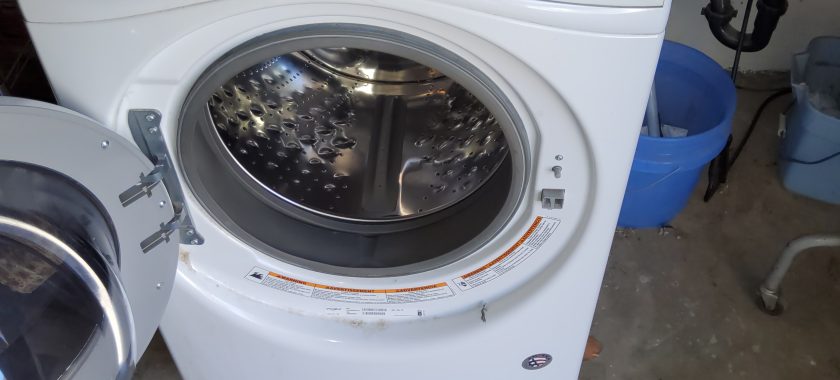A washing machine leak can be more than just an inconvenience — it’s a clear sign that something is wrong with the appliance’s sealing system. One of the most common sources of leaks is the door area. When water seeps from the front of a washer, it often indicates a damaged door seal (gasket) or a misaligned door hinge. Understanding these two common culprits can help you spot problems early, prevent water damage to your home, and maintain your washing machine’s efficiency.
1. How the Door Seal Works
Front-loading washing machines rely on a rubber gasket, or door seal, to create a watertight closure when the door is shut. This flexible rubber ring keeps water from escaping during the wash and rinse cycles. Over time, however, the gasket can become cracked, worn, or coated with detergent residue and mold, compromising its ability to seal properly.
If your washer leaks during operation, inspect the rubber seal around the door. Look for:
- Cracks or splits in the rubber.
- Mold or detergent buildup preventing full contact.
- Objects trapped under the seal, such as coins, buttons, or lint.
Even a small tear or gap can allow water to leak out during high-speed spins or rinse cycles. Regularly cleaning the seal and removing debris is key to avoiding leaks.
2. Damaged Door Seal: Causes and Consequences
A damaged or worn seal is the number one cause of door leaks. Common reasons include:
- Aging: Rubber naturally deteriorates over time, especially in hot and humid conditions.
- Improper cleaning: Detergent residue and mold can weaken the material.
- Foreign objects: Sharp items like zippers or metal buttons can tear the gasket.
- Improper door closure: Slamming or forcing the door shut can damage the seal’s alignment.
Once the gasket is damaged, it cannot maintain a watertight fit. Water seeps out, often trickling down the front of the machine. If left unchecked, it can lead to floor damage, rust on the machine’s frame, or even short circuits in electronic components.
3. Misaligned Door Hinge: A Hidden Problem
A misaligned door hinge is a less obvious but equally important cause of leaks. If the door isn’t closing flush against the seal, water will escape — even if the gasket itself is in good condition.
Signs of a hinge problem include:
- The door feels loose or uneven when closed.
- Visible gaps between the door and the gasket.
- Difficulty locking or latching the door.
Hinges can become bent or loosened due to frequent use, accidental impacts, or heavy loads pressing against the door during spinning cycles. Adjusting or replacing the hinge can restore proper alignment and eliminate leaks.
4. How to Diagnose the Source of the Leak
Before calling for service, you can perform a quick inspection to identify the likely cause:
- Wipe the seal clean. Remove any visible debris or detergent residue.
- Run a short cycle. Observe carefully if water starts dripping from the lower part of the door.
- Check for alignment. Close the door and see if it sits evenly all around the seal.
- Inspect the gasket. Look for cracks, tears, or areas that appear flattened or worn.
If water continues to leak even after cleaning the gasket and checking alignment, it’s time to call a professional technician.
5. Preventive Maintenance Tips
To prevent future leaks and prolong your washer’s lifespan:
- Clean the gasket regularly. Use a damp cloth and mild soap to remove dirt and mold.
- Leave the door open after use. This allows moisture to evaporate and prevents mold buildup.
- Avoid overloading. Too much laundry can strain the door hinge and deform the seal.
- Check for foreign objects. Always inspect pockets before washing clothes.
These small habits can make a big difference in maintaining your washing machine’s performance and avoiding costly repairs.
6. Professional Repair and Replacement
If your washing machine is leaking from the door despite cleaning and basic maintenance, you may need professional help. A trained technician can:
- Replace the worn or torn gasket with an exact manufacturer-approved part.
- Realign or replace the door hinge.
- Check for underlying issues, such as excessive vibration or warped components.
Attempting to fix the seal or hinge yourself without proper tools can worsen the problem. Incorrect installation can lead to recurring leaks and water damage.
7. Don’t Ignore the Leak
Even a small drip can indicate a larger issue. Over time, water exposure can damage floors, walls, and nearby appliances. Ignoring leaks also risks further damage to internal washing machine components, resulting in more expensive repairs down the line.
The best solution is timely professional service — a small repair today can prevent significant costs tomorrow.
If your washing machine leaks from the door or you notice damp spots on the floor after washing, don’t wait. Contact the professionals at Chula Vista Appliance Repair Company. Our experienced technicians will quickly diagnose whether the issue lies in the damaged door seal or a misaligned hinge, and restore your washer to perfect working condition.
We service all major brands and models, providing reliable, affordable, and efficient appliance repair.
Call Chula Vista Appliance Repair Company today for fast and professional washer repair you can trust!
Contact us
(619) 880-5508


